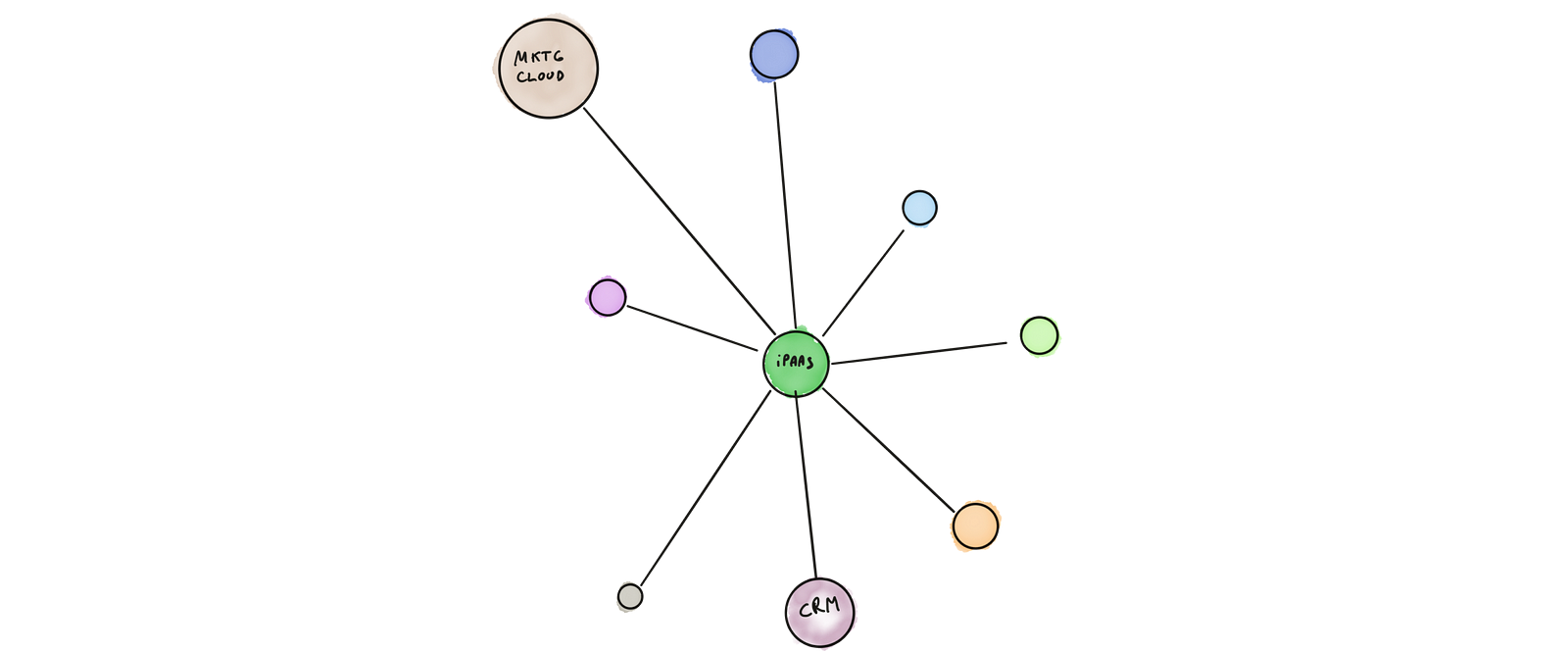iPaaS will be the Abstraction Layer for Customer Experience
Marketing acts like a giant pendulum.What worked a year ago may not work today. What’s working today may no longer work a year from now. In the era of SaaS and digital products, opportunities get saturated, best practices become overused, everything suddenly becomes highly measurable, more predictable, and over-optimized. Things that we relied on become less effective over time and its efficiency fades out.
Everything in marketing is doomed by this rule.

In my last post, I outlined the process that we’ve been witnessing over the last 5 to 7 years, essentially a deep decentralization of the marketing stack. We started to think that marketing would be better served by an archipelago of different vertical, loosely coupled highly specialized products, rather than the traditional monolithic approach.
While this “microservices marketing” approach is relatively new and not evenly distributed in the industry, it has been widely adopted by some of the best software companies out there.
For most of these businesses, it turned out to be a true game changer. It allowed those organizations to design better and more relevant customer journeys, be more creative and effective, and bring more revenue to the table.
There are clear benefits to be gained from using a microservices design approach. These include cost effectiveness, more flexibility without the risk of vendor lock-in, and a general optimization of the customer experience.
But not everything that glitters is gold.
This massive decentralization leads to a number of drawbacks that will trigger the transition to a partial market re-centralization.
Here’s how these consolidation thrusts will manifest in the Marketing Tech landscape:
iPaaS Abstraction Layer for Customer Experience iPaaS (Integration Platform as a Service) that act system orchestrators highly specialized in marketing technologies able to seamlessly coordinate different products via web APIs will emerge in the tech scene.
Segment is one software that understood this early on, and it has helped businesses seamlessly integrate with different products without the traditional engineering burst.
We are about to go much, much deeper.

Businesses will actually need systems not only to integrate but to orchestrate inputs and outputs coming from the variety of systems included in their stack.
iPaaS will solve that problem and will establish itself as the abstraction layer for customer experience, just like Docker containers have become the abstraction layer above the OS.
SaaS Pricing redundancy
When you are using multiple SaaS products that charge in a variety of ways (per seat, per usage, per outcome generated, per API call, etc..) your marketing tech spend can become highly unpredictable.Pricing methods of today’s SaaS systems are extremely interconnected and rely on a multitude of dependent variables. The more leads you have, the less seats available in your CRM, the more API calls to enrich those prospects, the more emails you need to send.
For every customer operations unit, your pricing might increase in a non-linear way. Finding a configuration balance between your software products is a total mess.
iPaaS will abstract that pricing layer of complexity by making bundled packages that include the software in the right dose that you need to compose your stack.
By paying a single pricing tier, you’ll have access to a multitude of underlying, invisible products.

iPaaS UX Shared Layer
The tool explosion made companies more flexible, but it also requires a lot of back and forth between apps just to accomplish a given task (wasting more time than you might think).With a microservices design approach, you are still using a variety of interfaces that act and behave in many different ways.
Each of them is unique in its own way and requires its own learning curve.

Organizations need highly specialized vertical products for their ultimate outputs and their relevant impact on the business, not because they like to engage with multiple interfaces. (They want to use “best of” throughout their stack: best enrichment product, best predictive analytics product, best email deliverability software, best NPL tool for parsing text, etc..)
The SaaS explosion scattered these elements of our “work” into pieces across a dozen workspaces, making it impossible to focus on a self-confined environment. The switching costs from a pure routine perspective today are higher than ever.
We’ll see a new wave of Anti-Active Usage products that will flip the traditional model.
You won’t necessarily need to use the high-level product’s interface to get something done, you’ll just use the outputs. Anti-active usage products don’t need human interactions at any level of their value chain.
There will be a lot of UX challenges on the iPaaS side to make a shared UX baseline flexible enough to be modeled and adapted to a diverse range of 3rd-party products. At the same time, these low-level products will also be challenged in how they convey and demonstrate value to their own customers.
iPaaS Customer Data Ubiquity
Today’s customer data is the fuel of tomorrow’s customer experiences. Fragmented or skewed data leads to fragmented or skewed customer experiences.Anyone who wants to be able to affect the customer experience will need to tap into a shared customer data layer able to provide the most transparent and up to date customer context at any time.
No matter how creative and flexible your “decentralized stack” maybe, it won’t be effective if you’re unable to retrieve and exploit all of your SaaS data in conjunction with other 3rd-party system data.
Customer Data Platforms are a first solution attempt in this direction, but they haven’t built the bridge between data owners and decision-makers.
0 comments:
Post a Comment